ABOUT FEATHER
page under costruction
Many people seem to be very confused about what is considered "feathered", and what is considered "well feathered". We see many ads for these horses on the web that say the horse is "heavily feathered", of that it has "tons of feather" and things like this, and when we look at the horse we just sigh. Yes, it may be a good deal of feather compared to a light horse, or a Belgian draft, or even a Friesian, but that is NOT acceptable feathering for a gypsy horse. Below are some examples and comments on what is, and what is not, good feathering for a gypsy horse.
For this discussion on feather, we will leave out all of the other things that make a horse into a good horse, and focus on the feathering, a very important part of the gypsy horse (cob, vanner, Irish cob, whatever you like to call them), breed. For the horses used as examples, we will assume that they all are equal in conformation and training, for the purposes of this article. This way we can "get to the heart" of this weighty issue in our chosen breed of horse. We realize that very few people get to spend the time that we do with the true gypsy people who created this breed, and want to share a bit of what we have learned over the years in relation to this matter.
In basic terms, "feathered" means that a horse has ground-length hair completely around the hoof. If the hair in the front of the hoof doesn't naturally grow longer than about an inch, then you DO NOT have a feathered horse. These parts are very important, but just being technically "feathered" doesn't make your gypsy horse acceptable by gypsy standards. If a horse has a light amount of hair all the way around the hoof, but it's not THICK and FULL, then, by gypsy standards, this is not a high quality gypsy horse (of course this excludes horses that have been shaved, or "bog burned").

Feather on a Friesian horse.
To Shire, Clydesdale, or Gypsy Horse breeders, this is NOT a "feathered" horse. To gypsies, the people who created our beloved breed of horse, there is no such thing as too much feather. A moderately feathered stallion is never acceptable, a stallion has to have as much feather as is at all possible. If a gypsy breeder is breeding a stallion that doesn't have an incredible amount of feather, he is a poor breeder, who doesn't have the money for good stock. "Each hair is a sovereign" is a term used by many of the old traditional breeders. This would translate to "each hair is a dollar" to us Americans. This is basically the "bible" of gypsy horse breeding, as the cheap horses don't have too much hair, and the expensive ones are the well bred, quality horses, that also have tons of feather.
Feather is a recessive, and it is accumulative. If you breed a feathered horse to any non-feathered horse, you DO NOT get a feathered horse. If a gypsy horse doesn't have too much feather on it, the reason for this is that it has non-feathered horse in it's pedigree - not too far back! If the horse has barely any feather on the front of the hoof, but a decent bit off the back of the fetlock, this horse has light-horse bred into it, mostly likely as one of it's parents! There are actually dozens of these horses that have been imported into the USA that are direct, first generation crosses, but have been sold as "pure gypsy horses". This is not a good situation, to say the least! I will state again, if a "gypsy horse" doesn't have full feathering around the front of it's hoof, that reaches the ground, it is recent-generation cross-bred horse (and very likely a first generation cross)!
Mares are feathered too in this breed! Many people will try to tell you that a mare doesn't have to have much feathering to be a gypsy horse. Don't buy this! Of course, there are "degrees of feathering" which I will show examples of below, but unless the mare has feather all the way around the hoof to the ground, she is just another "worthless" horse. Below I will show you what a true gypsy breeder would consider acceptable, and what that breeder would not. Not all mares can be "the heaviest mare" around, but there are limits as to what amount is acceptable to proper breeders. There is never a reason to breed a gypsy horse mare that has what a gypsy horse breeder would consider to be an unacceptable amount of feather. Doing this won't give you a nicely feathered horse, it will only give you a horse with slightly more feather than the mare, no matter how heavy (in feather) the stallion is.
Bigger horses. Many of the larger (over 16 hands) gypsy type horses (and drum horses) have a good amount of Shire or Clydesdale blood in them. These don't get as heavily feathered as the traditional gypsy horses, but should have AT LEAST as much feather as a Shire or Clydesdale. This means full hair growing around the FRONT of the hoof all the way around. Any less means that you don't have a feathered horse. If you have a 14 or 15 hand horse with that lesser amount of feather, you have a "trade horse", one that most true gypsy *breeders* wouldn't take a second look at .
Rule to live by in gypsy horses: hair isn't everything, but, you can't have everything unless you have the HAIR!
EXAMPLES
Stallions: Stallions need to have feather in order to be considered worth breeding in the gypsy community. Not just feather, but TONS of feather.
Figure 1.) This is the feather of one of the top stallions (7 years old) in England. This guy has thicker feather than some of the silky-feathered stallions. The heaviest-feathered stallions are usually this type of feather. The feather MUST start on the front of the cannon bone at the knee for a colt to even be considered for growing up for stallion potential.

Figure 2.) Feather of a 6 year old stallion. Not coarse, not silky, somewhere in between.

Figure 3.) Feather of a 5 year old well bred gypsy stallion. Although it's not clean or brushed out, this is the straight, silky feather that is so in demand among gypsy breeders. This is about as much hair as you will see on a straight-feathered stallion. If the hair is in good shape (not burned out or anything), and you can see hoof, you don't have a good stallion. NOT ALL horses will grow feather like this.

Figure 4.) Feather of a 3 year old stallion. In stallions, this is about the least amount of feather that would be acceptable to even the poorest of gypsy breeders. This is mid-grade feather, not straight, but not curly either. By 3 years old a stallion has pretty much all the feather he will ever have (unless it's burned out or shaved or something). Anyone who tells you different that this is trying to sell you an inferior horse!
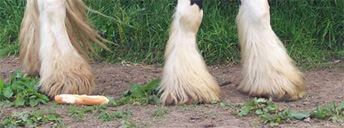
Figure 5.) Feather of an 8 year old stallion. This is an unacceptable amount of feather in a stallion over 6 months old. No proper gypsy breeder would even consider this horse for breeding under any circumstance. This horse is a cross between a feathered gypsy horse and a non-feathered horse, but was sold as a full gypsy stallion. This is a good example of a "half-legger". Compare this full grown stallion to the 2 year old colt below (figure 8), you will definitely see the difference! I was lucky enough to see these two horses together at one time, and I had doubts as to whether they were even of the same breed. A horse like this would be sold at auction in England or Ireland for about £800 (English pounds), which translates to about $1200.00 (dollars), IF he were trained to ride or drive. If he weren't trained, he would have sold by the pound for a ride to the butcher.

COLTS:
Figure 6.) Feather of a 2 year old colt. Any 2 year old that only has this much feather will be gelded and sold on, never to be bred. This is the amount I would expect to see on a weanling colt. On a yearling colt it would be marginal, but on a 2 year old, it's unacceptable.

Figure 7.) This 5 MONTH old colt has as much hair in front (this is where the difference is at this age, the front of the hoof) as the 2 year old colt above. Don't make the mistake of looking at the back of the leg to determine how much feather a horse has! Some Belgians and Friesians have hair in the back that goes down to the ground, but still none in the front. Remember, that's not a feathered horse.

Figure 8.) Feather of a 2 year old colt with excellent feathering, a prized colt from one of the best known gypsy breeders. You can see there is a Profound difference between the 2 year old colts in figures 6 and 8!

Figure 9.) A yearling colt with lots of great, straight, silky feather. Grade = excellent, you will have a hard time finding more in a yearling.
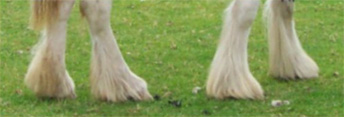
Figure 10.) A yearling colt with a nice amount of feather. Grade = good, has good potential.

Figure 11.) A yearling colt with an average amount of feather. Grade = acceptable. The length is almost at the ground already in front, but it is not as full as some of the other colts. Any less on a yearling is not acceptable in a potential breeding stallion. This yearling still has a good amount more than the 2 year old in figure 6!
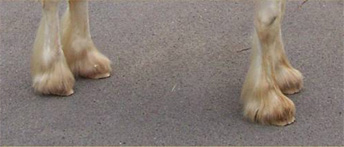
"Flow Chart"
Top class: A young colt like the five month old in the figure 7 becomes a yearling like figure 9, which becomes a two year old like figure 8, which becomes a stallion like figure 3.
Middle class: A colt like the yearling in figure 10 becomes a stallion like the three year old in figure 4. These are the types that the poorer, but still proud gypsy breeders will breed. Not bad, but not the best.
Not even in the same class: In contrast: A two year old like figure 6 will turn into a stallion like figure 5. Don't let unscrupulous sellers try to tell you that they will eventually get tons of feather like the horses you see in the calendar pictures. If they don't start out with feather, they will never have it.
Mares: The heaviest mare won't have as much feather as the heaviest stallion, but a good mare will have more feather than an average stallion. The heaviest (this means feather) horses around will be stallions, but the top mares anywhere will be close in feather amount. Those mares are few and far between, but that shouldn't be an excuse to take an unacceptably feathered mare and try to breed something good with her. It just won't work, which has been proven over generations by our gypsy breeders. We don't need to reinvent the wheel with these horses, all the hard work has been done for us by the gypsies. Put your money into buying what they consider to be a good horse, and you will never be disappointed, either personally or financially. Mares are every bit as important as stallions (some say more important) in breeding, so don't make the common mistake of getting a decent stallion and trying to fix inferior mares with him. That trick never works.
Foals: It's easiest to get a good idea of hair in a foal by waiting til he is close to a year old. Another good way to get some sort of idea is by looking at the parents. This does not mean that the two heaviest parents will always produce the heaviest foal, but I can guarantee that two unacceptably feathered parents will NEVER produce an acceptably feathered foal. If you breed a mare like this
(figure - Mare 1)

or this
(figure - Mare 2)

to a stallion like the one in figure 5, you will get a foal like the two year old pictured in figure 6, who will never have more hair than his parents. If you breed a mare like Mares 1-2, to a great stallion, you will get somewhat more hair, but still not as much hair as you, and the market, want. Remember, hair is accumulative and recessive. If you wantlots of feather, you have to breed from lots of feather ON BOTH SIDES. Even this does not always give you incredibly heavily feathered foals, but it's the only way to even have a chance. Breed the most feather you can afford to the most feather you can afford, and you have a prettygood chance of producing what the educated buyer wants.
Figure - Mare 3 - Feather of a three year old, larger mare. This is about the least amount of feather that is at all acceptable in a mare (and only if she is the larger sized, shire-ish type of mare). It still covers the front of her hooves, so it is "feather" by definition, but it's not good feather. Put to a greatly feathered stallion, she has a good chance of producing an acceptably feathered foal. A mare with this amount of feather shouldn't be too expensive to buy. She still has much more than the mares in figures 1 and 2 (and those mares are both mares who have been imported into the US as pure gypsy horse mares!!).
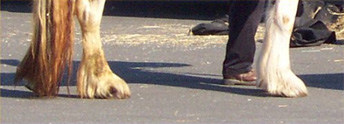
Figure - Mare 4 - Three year old mare - unacceptable. It doesn't matter what kind of bloodlines a mare like this is *supposed* to have, one like this is considered "worthless" to any true gypsy breeder, even the poor ones. I have NEVER found a mare like this one in a broodmare field of a true gypsy breeder, but I have found hundreds of horses like her in the horse dealers fields. A mare like this would sell at auction for between £500 and £800 (English pounds), which translates into about $750 to $1200 dollars. With import fees, this mare should sell for about $8000, but why would she? It makes no sense to spend the money on flight and quarantine on a cheap auction horse! Wouldn't we Americans get a good laugh if someone from Europe came over to the USA to go to the local horse auction house, to buy our cheap, inferior grade horses, only to spend thousands upon thousands to export that horse to another country as a special breed! Don't make the Europeans laugh at you by buying a horse like this one!

Figure - Mare 5 - By contrast, another 3 year old mare. This gal has the right kind of silky feather starting up at the knee in front like it should. It would be fuller and silkier if it were clean, but you can get the general idea. BIG difference in the two mares! Unfortunately for the buyer of the above mare, the prices on the two mares were similar! Beware of unscrupulous sellers that will tell you that hair like in figure 'Mare 4' is acceptable!

Figure - Mare 6 - Four old mare. Grade - Very good. Nice and silky, and plenty of it coming from the knee IN FRONT, just as it should. This is a very high-class mare in the hair department.

Figure - Mare 7 - Top of the line six year old mare. Grade - Excellent, as good as it gets in a mare. This is the kind of mare you need to produce foals like in figure 9. This is the kind of mare that has more hair than most stallions. If she were a stallion, she would be like the stallion in figure 1.

Figure - Mare 8 - Two year old filly. This filly will turn into a mare like figures 6 or even 7. She has wonderful feather for a two year old.

Yearling filly feather

Unacceptable feather in a yearling filly. By this age, it should be well down the hoof in the front. This gal will never have hair worth anything. She is "worthless" in the eyes of gypsy breeders.

Nice feather

Really nice feather

Exceptional feather,
REALLY hard to find in a yearling filly!
"Bog Burn", AKA "Burned Feather" - No discussion on feather is complete without mentioning the problem of "Bog Burn" in feathered horses. This is a problem caused by a feathered horse being kept on wet land for extended periods of time. It's a bigger problem in the winter months, because ice can play a part in it, although ice is not required to bog burn a horse. Since the winter of England and Ireland consists mostly of mud and more mud, this is something that you see often in gypsy horses. Gypsies keep their horses outdoors, on fields, almost exclusively. They try hard to get "good land" in the winter time so as not to "ruin" their horses, but that is not always easy to do, unfortunately. Sometimes they are forced to use land that they know will "ruin" the feather on their horses in order to keep the horses well fed. "Ruin" isn't really the proper term, as when the hair is pulled out it grows back of course, but if you have a great mare or stallion in perfect condition feather-wise, it is a huge disappointment to have all that perfect feather pulled out, and have to wait months before it looks the same again.
It isn't too tough to tell the difference between a bog-burned horse and a horse that is just poorly feathered, but it does take some experience at looking at different types of feathered feet.
Photos below: The first picture is a 9 year old mare of great breeding, but that was kept on bad land through the winter and spring earlier this year. The picture on the left was taken in July, after about a month of the hair growing back. The picture on the right was taken 10 weeks later. The hair isn't completely back, but it's almost there! This mare will have hair in front that drags the ground, like a good mare should have! To the untrained eye, the picture on the left could look like a mare with not-good feather. The short in the front and long in the back is a classic symptom of bog burn, but that is also a trait of not-so-great feathered horses. It takes a bit of practice looking to notice the subtle differences between a burned, well feathered horse, and a half-legged horse that doesn't naturally have much feather. Many unscrupulous dealers will tell perspective buyers that a horse is just burned when it's actually a non-feathered horse, so be careful, and know that you can trust the person doing the telling.
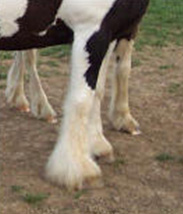

In closing:
Don't waste money on importing a gypsy-type horse that the gypsies consider inferior. If it doesn't have much feather, it's not worth much to them, so it won't be worth much to a knowledgeable American buyer. Don't make the mistake that so many unknowing buyers of gypsy horses/Irish cobs have made, of buying a horse that will make you a joke in the gypsy horse world! If you have already made this mistake, cut your losses and start again. Don't keep "beating a dead horse" and trying to breed something good from something that will never be what you thought you were buying.
Nobody sets out to own or breed a gypsy horse with a moderate amount of feather. We all love this breed because we are crazy about the incredibly feathered look that we see in the top horses of the breed. There are well-feathered horses available in the price range that most Americans are paying for unacceptable horses, so there is really no good reason to waste money on an unacceptably feathered horse. If you do, you will be regretting it for years to come, as your foals won't be nearly as saleable as their properly feathered counterparts. You may save a few dollars in the first place, (again, that's not always the case, some of the unacceptable ones sell for the same money as the good ones!) but you will be paying for it for the rest of your gypsy horse career.
It costs just as much to import a "trade horse" as it does to import a good traditional gypsy horse, so be informed before laying out your hard-earned cash. The horse you are looking at might be really pretty, and really sweet, but unless it has the amount of feather described above in good gypsy horses, you are NOT buying a good quality, traditional gypsy cob.


